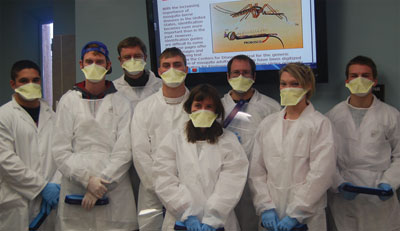West Nile virus subject of student research
January 1, 2012

Central Wyoming College students involved in a long-term undergraduate research program are ramping up to carry on a study of West Nile Virus in Fremont County.
A team of bright and committed students working with Professor Steve McAllister are continuing research this spring and summer, which includes a greater sampling of Fremont County subjects, an examination of local mosquito and bird populations and an investigation into the relationship of climate and prevalence of the virus.
In 2008, one year after a majority of the state’s West Nile cases were reported in Fremont County, McAllister and his students embarked on a study of the virus. Armed with resources from a grant through INBRE (Idea Networks for Biomedical Research Excellence) students have been collecting blood samples from local residents as well as examining the county’s mosquito population.
Though the students have made some preliminary conclusions from the blood tested from about 100 Lander and Riverton volunteers, the team intends to expand its sample to better match county demographics using a microfluidic device that will simplify the collection, said team member Kelly Niemeyer. The device, she said, allows the student researchers to obtain a blood sample with a simple finger prick, which is then transferred to a miniature chip.
Niemeyer and other CWC researchers have been taught how to prepare the chip by Dr. Debashis Dutta of the University of Wyoming Chemistry Department who has written a grant to involve UW and CWC students in the use of this “cutting edge” device, McAllister said. Niemeyer has written a proposal on collecting the samples and preparing the chip to test for West Nile Virus.
The group, which has used the ELISA (enzyme-linked immunosorbent assay) method to test the first collection of blood samples, intends to re-test using the microfluidic device.
Jonathon McFall and Seth Hosking are two team members from Riverton who last summer determined the mosquitoes they tested in the county were not carrying West Nile Virus. Mosquitoes spread the virus after they feed on infected birds and then bite people, other birds and animals, said McFall, who McAllister said is the team’s resident entomologist.
McFall and Hosking will test mosquitoes again this summer and Josh Graham will head up a study of the local bird population to determine if they are hosts of the virus.
Since the prevalence of the virus has markedly decreased in the county, the team is also looking at the relationship of climate. “We haven’t figured out why it has declined,” said Graham, a CWC sophomore from Riverton. “We think it may be the mild weather.” Only three cases of WNV were reported in Wyoming in 2011.
With such a high number of cases in the county in 2007, the researchers were under the assumption that a majority of the county’s population was exposed to the virus but did not get any symptoms. From the preliminary sampling, however, the team’s study indicates only 16 percent of those volunteering to have their blood tested had been exposed, a majority of which had indicated a previous positive test or belief they had been exposed to the virus.
“That was really interesting to us. We thought maybe 80 to 90 percent had been exposed,” said Graham.
The first collection by the students was limited to Riverton and Lander residents and they had tested more women than men. In the next sampling, the students want to get volunteers from the Wind River Indian Reservation and other rural communities in the county to match the county’s demographics.
McAllister said the students will also be testing for two kinds of antibodies that human bodies produce to get a handle on when the subjects were exposed.